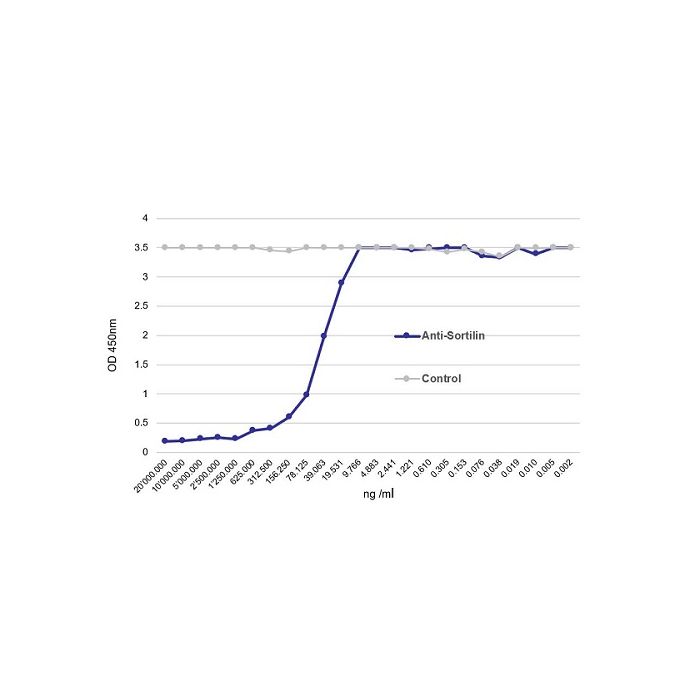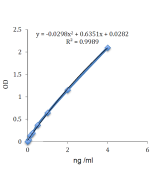Cookie Policy: This site uses cookies to improve your experience. You can find out more about our use of cookies in our Privacy Policy. By continuing to browse this site you agree to our use of cookies.
AdipoGen Life Sciences
anti-Sortilin (human), mAb (rec.) (blocking) (preservative free) [Latozinemab]

Methods: Progranulin (human) (rec.) (untagged) is coated on an ELISA plate at 1 µg/ml. Sortilin (human), mAb (rec.) (blocking) [Latozinemab Biosimilar] or an unrelated mAb (Control) is added (starting at 20 µg/ml with a twofold serial dilution) together with 250 ng/ml of Sortilin (rec.) (His) for 1 hour. The binding is detected using an anti-His (HRP) incubated for 30 minutes followed by addition of the substrate TMB. The decreasing ODs observed in the Y axis represent the binding between Progranulin and Sortilin that is inhibited in a dose-dependent manner by Sortilin (human), mAb (rec.) (blocking) [Latozinemab Biosimilar]. This inhibition is not observed with the control antibody.
| Product Details | |
|---|---|
| Synonyms | Latozinemab Biosimilar (RUO); AL001; 100 kDa NT Receptor; Glycoprotein 95; Gp95; Neurotensin Receptor 3 ; NT3; NTR3; CAS 2376132-27-1 |
| Product Type | Monoclonal Antibody |
| Properties | |
| Clone | Latozinemab |
| Isotype | Human IgG1κ |
| Source/Host | CHO cells |
| Immunogen/Antigen | Recombinant human Sortilin. |
| Label/Conjugates | Preservative Free |
| Application |
Functional Application (Blocking): Inhibits sortilin binding to progranulin. |
| Crossreactivity | Human |
| Specificity |
Recognizes and binds to human sortilin. |
| Purity | ≥95% (SDS-PAGE) |
| Purity Detail | Protein A/G-affinity purified. |
| Endotoxin Content | <0.001EU/μg |
| Concentration | 1mg/ml |
| Formulation | Liquid. In PBS. |
| Isotype Negative Control | |
| Other Product Data |
UniProt ID Q99523: SORT1 |
| Accession Number | Q99523 |
| Shipping and Handling | |
| Shipping | BLUE ICE |
| Short Term Storage | +4°C |
| Long Term Storage | -20°C |
| Handling Advice | Avoid freeze/thaw cycles. |
| Use/Stability | Stable for at least 1 year after receipt when stored at -20°C. |
| Documents | |
| MSDS |
 Download PDF Download PDF |
| Product Specification Sheet | |
| Datasheet |
 Download PDF Download PDF |
Sortilin is a type I transmembrane multiligand receptor that is a member of the Vacuolar protein sorting 10 protein (Vps10p) domain receptor family. It is a 95 kDa protein, ubiquitously expressed, although most abundantly expressed in neurons, hepatocytes, adipocytes and white blood cells including macrophages. Sortilin is synthesized as a propeptide in the endoplasmic reticulum (ER) and processed to its mature form by furin-mediated cleavage in the trans-Golgi network. The SORL1 gene is one of the strongest genetic risk factors for Alzheimer's disease and is associated with frontotemporal dementia.
The primary function of sortilin is trafficking proteins from the Golgi to secretory vesicles and endolysosomal compartments. The majority of trafficking is from the Golgi to the endosomal compartment where sortilin deposits cargo targeted for catabolism in the lysosome and then is trafficked back to the Golgi via a retromer complex. At the cell surface, sortilin can remain intact and act as a receptor for extracellular ligands that can initiate signaling cascades or be internalized as a method of receptor-mediated endocytosis. Additionally, cell surface sortilin protein can undergo an additional cleavage that results in the release of the soluble form of the protein into the extracellular space.
The sortilin receptor binds the nerve growth factor precursor (proNGF), neurotensin and Progranulin (PGRN), a secreted growth factor implicated in a multitude of processes ranging from regulation of inflammation to wound healing, tumorigenesis and neurological diseases. Sortilin controls PGRN trafficking (endocytosis) and is indirectly involved in lysosomal degradation of PGRN. Sortilin down-regulation via blocking antibodies, such as Latozinemab Biosimilar, is a key mechanism in increasing extracellular PGRN levels suggesting that sortilin is a potential target to correct PGRN reduction, such as that in patients with frontotemporal dementia (FTD) caused by GRN mutations.








